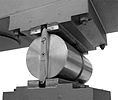Span (construction)
Span or span in construction refers to the length that is spanned by a component ( bridge , vault , roof , floor slab ) between the elements supporting this component ( abutment , pillar , column , support , load-bearing wall) without any other support. In the case of ropes and chains , the span describes the length between the two suspension points of the rope or chain.
The term is only apparently precise. Its content changes depending on the context in which it is used. The occasional centimeter-accurate specification is therefore mostly misleading outside of the statics.
Structural analysis
In structural engineering , span or support span denotes the distance between two support or suspension points of a structure. Since a support point in statics, just like the point in geometry , is understood as an object without expansion, the span can be specified with a precise length dimension, which is used in the precise form in structural planning .
Stone arch bridge
Brick arch bridges without joints were built over centuries on the basis of empirical values , as their theoretical static conditions were not yet known. Their span in terms of the distance between precisely defined support points can therefore not be determined. That is why they usually specify the distance between the ends of the arches on the spars as the span of the bridge arch .
Two and three hinged arches
In a two- or three- hinged arch , the distance between the two lower transom joints, which sit in the center of gravity of the arch, is called the span or span , which is greater than the distance between the lower ends of the soffit due to the strength of the arch.
Clear width
Often with span the clear width designated between the bridge abutments, which may be much smaller but with projecting pillars than the distance between the sheet ends. The distance between the pillars says little if the pillars stand on wide plinths that further narrow the space between them. The distance between the bases does not necessarily contain any information about the width available for the crossed river or the roadway if the pillars are on the slope above the bank or the valley floor.
Girder bridge
In the case of a girder bridge , the superstructure of which is separated from the substructure by bearings , the span or span is determined by the distance between the bearing centers. In the case of roller bearings, it is the distance between the axes of the bearing rollers. In the case of bearings with two rollers or elastomer bearings, it is the distance between the bearing axes. The clear width of a girder bridge is significantly smaller, as the pillars and abutments under these bearings are much wider than the bearings themselves.
Pillar spacing
For bridges with multiple fields and pillars, the term span often synonymous, but not strictly correct, used for Pfeilerachsabstände. The axes of the pillars are their vertical central axes, which were used as the basis for the planning of the bridge and which are then decisive for the other elements of the bridge, e.g. B. for the exact positioning of the pillars, which are often several meters thick, and their foundations, the length of the individual deck girders, the arrangement of their bearings and the resulting span. The addition of the pillar spacing results in the length of the bridge between the abutments . On the other hand, the sum of the spans would have to be supplemented by the distances between the supports in order to arrive at the same result.
Suspension bridge, overhead line
In suspension bridges , the static bearing point is usually in the central axis of the pylons , which are often several meters thick , so that the span of the suspension bridge is the center distance of the pylons, but not the length of the bridge deck between the pylons, which is often blurred with this term.
In the case of high-voltage lines , the span between 2 masts is the linear distance between the mounting points of the insulators on the masts under consideration. The span is determined solely by the attachment points on the mast pair at the ends of a so-called span field. The span defined in this way is not influenced by any changes in the geometry of the insulators mounted on tension - their length, direction, deflection. The curved length of the typically sagging conductor cable is significantly longer than the straight span.
Individual evidence
- ↑ Architecture Lexicon
- ↑ Span in: Otto Lueger: Lexicon of the entire technology and its auxiliary sciences , Vol. 8, Stuttgart, Leipzig 1910, pp. 162–166.



